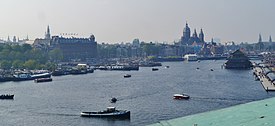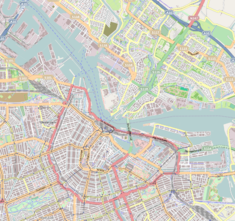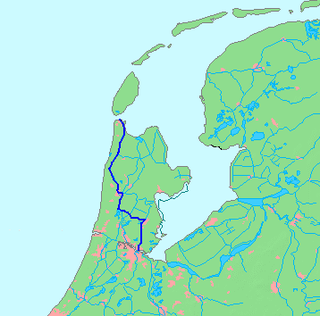
The Noordhollandsch Kanaal is a canal originally meant for ocean-going ships. It is located in North Holland, Netherlands. The canal was of great significance in Dutch history.

Willemsoord is a large former naval base of the Royal Netherlands Navy in Den Helder. It is now connected to the city center of Den Helder, and focuses on entertainment and tourism.

The Eastern Docklands is a neighborhood of Amsterdam, Netherlands, located between the IJ and the Nieuwe Vaart in the borough of Amsterdam-Oost. The harbor area was constructed in the late nineteenth century to allow for increasing trade with the Dutch East Indies; a new location was necessitated by the construction of the Amsterdam Centraal railway station, which replaced the old quays. East of the new station was a marshy area called De Rietlanden, with the Zeeburgerdijk, running via the Zeeburch, a fort, to the Zuiderzee.

The Voorne Canal is a former ship canal on Voorne-Putten in South Holland, the Netherlands. It was the first canal to connect Rotterdam to the sea. Construction of the canal started in 1826 and was completed in 1829. Until the completion of the Nieuwe Waterweg in 1872 it was the main connection from Rotterdam to the sea for ocean going ships.
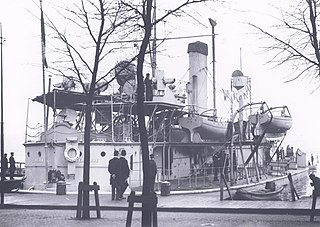
HNLMS Cerberus, was a Heiligerlee-class monitor built in Amsterdam for the Royal Netherlands Navy in the 1860s. Cerberus was a true monitor: a ship with shallow draught, only a few (heavy) guns and decent armor. These characteristics made her very suitable to operate way inland in the Dutch delta.
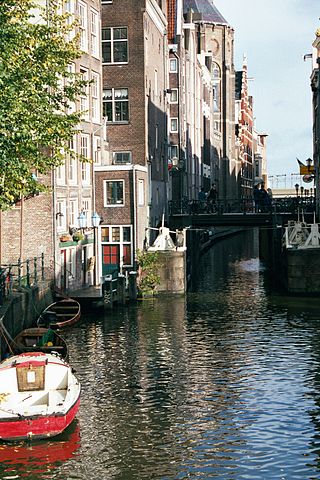
The Oudezijds Kolk is a short and narrow canal/lock in Amsterdam between the Oudezijds Voorburgwal and the Oosterdok.
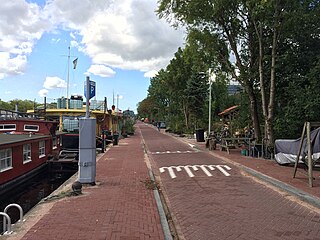
The Dijksgracht is a canal in the center of Amsterdam, north of the three Oostelijke Eilanden. It is also the name of the adjacent street.

The Oudeschans, or Oude Schans, originally the Nieuwe Gracht, is a wide canal in the eastern part of the inner city of Amsterdam.

The Nederlandsche Scheepsbouw Maatschappij, was a Dutch shipbuilding company based in Amsterdam. It existed from 1894 to 1946. From c. 1908 it was the biggest Dutch shipbuilding company.

Willemsoord Dry Dock I is a historic dry dock in Willemsoord, Den Helder, Netherlands. It was constructed from 1813 till 1822, under the direction of Jan Blanken, and was part of the former Rijkswerf Willemsoord.
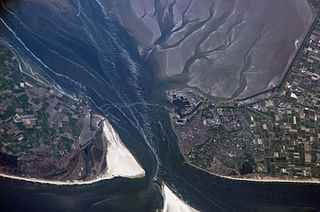
Nieuwediep was a canal and harbor. In about 1800 the major naval base Willemsoord was constructed west of it, soon followed by a major commercial port. After World War II, Nieuwe Haven Naval Base was built on reclaimed land east of the Nieuwediep, and the Nieuwdiep's source and mouth were dammed off.

Amsterdam Wooden Drydock I was the first floating dry dock of Amsterdam, and probably the first modern floating dry dock of Europe.

Amsterdam Wooden Drydock II was the second floating dry dock of Amsterdam, and was moored in the Westerdok.
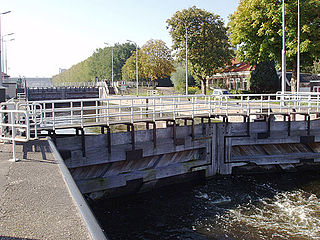
Willem I Lock is a monumental lock in Amsterdam-Noord.

Koopvaarders Lock in Den Helder, Netherlands connects the Noordhollandsch Kanaal to the Nieuwediep. There were 4 locks at Nieuwediep carrying this name.
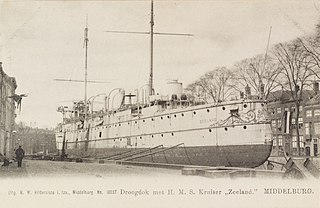
Middelburg Drydock is a former dry dock in Middelburg, Netherlands. The Dock chamber still exists.

Amsterdamsche Droogdok Maatschappij (ADM) was a Dutch company that repaired ships using dry docks in Amsterdam, Netherlands. After World War II it also built some ships.
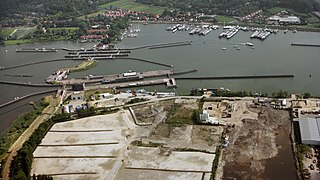
The Oranje Locks are a group of locks and other water management facilities just east of Amsterdam.

The Wilhelmina Canal is a canal in North-Brabant, Netherlands. It connects Tilburg to the Meuse, and continues to the east to connect to the Zuid-Willemsvaart north of Helmond.

Het Westerdok is a former wet dock in Amsterdam. It was created in 1830-1834 by constructing the Westerdoksdam and Westerdoksluis, forming a reliable deep port closed off from the tidal IJ. It lost its function in 1876 when the North Sea Canal was opened. About half of it has since been filled up.
